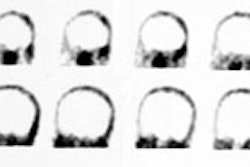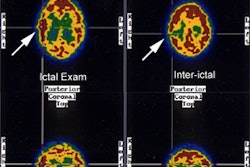J Nucl Med 2000 Oct;41(10):1619-26
Does performing image registration and subtraction in ictal brain SPECT help
localize neocortical seizures?
Lewis PJ, Siegel A, Siegel AM, Studholme C, Sojkova J, Roberts DW, Thadani VM,
Gilbert KL, Darcey TM, Williamson PD.
Ictal brain SPECT (IS) findings in neocortical epilepsy (patients without
mesiotemporal sclerosis) can be subtle. This study is aimed at assessing how the
seizure focus identification was improved by the inclusion of individual IS and
interictal brain SPECT (ITS)-MRI image registration as well as performing IS -
ITS image subtraction. METHODS: The study involved the posthoc analysis of 64 IS
scans using 99mTc-ethyl cysteinate dimer that were obtained in 38 patients
without mesiotemporal sclerosis but with or without other abnormalities on MRI.
Radiotracer injection occurred during video-electroencephalographic (EEG)
monitoring. Patients were injected 2-80 s (median time, 13 s) after clinical or
EEG seizure onset. All patients had sufficient follow-up to correlate findings
with the SPECT results. All patients had ITS and MRI, including a coronal volume
sequence used for registration. Image registration (IS and ITS to MRI) was
performed using automated software. After normalization, IS - ITS subtraction
was performed. The IS, ITS, and subtraction studies were read by 2 experienced
observers who were unaware of the clinical data and who assessed the presence
and localization of an identifiable seizure focus before and after image
registration and subtraction. Correlation was made with video-EEG (surface and
invasive) and clinical and surgical follow-up. RESULTS: Probable or definite
foci were identified in 38 (59%) studies in 33 (87%) patients. In 52% of the
studies, the image registration aided localization, and in 58% the subtraction
images contributed additional information. In 9%, the subtraction images
confused the interpretation. In follow-up after surgery, intracranial EEG or
video-EEG monitoring (or both) has confirmed close or reasonable localization in
28 (74%) patients. In 6 (16%) patients, SPECT indicated false seizure
localization. CONCLUSION: Image registration and image subtraction improve the
localization of neocortical seizure foci using IS, but close correlation with
the original images is required. False localizations occur in a minority of
patients.



